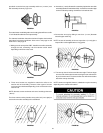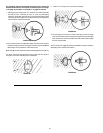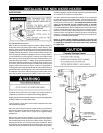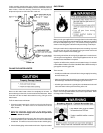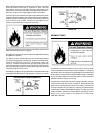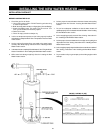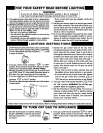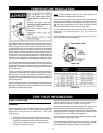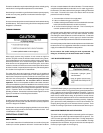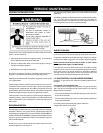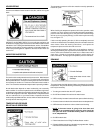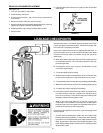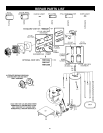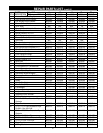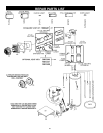
31
TEMPERATURE REGULATION
HOT WATER CAN SCALD: Water heaters are intended to produce hot
water. Water heated to a temperature that will satisfy space heating,
clothes washing, dish washing, and other sanitizing needs can scald
and permanently injure you upon contact. Some people are more likely to
be permanently injured by hot water than others. These include the
elderly, children, the infirm, or physically/mentally handicapped. If anyone
using hot water in your home fits into one of these groups or if there is
a local code or state law requiring a specific hot water temperature at
the tap, then you must take special precautions. Never allow small
children to use a hot water tap, or to draw their own bath water. Never
leave a child or handicapped person unattended in a bathtub or shower.
It is recommended that lower water temperatures be used to avoid the
risk of scalding. It is further recommended, in all cases, that the water
temperature be set for the lowest temperature that satisfies your hot
water needs. This will also provide the most energy efficient operation
of the water heater.
Figure 110 shows the approximate water temperatures produced at
various thermostat settings. Short repeated heating cycles caused by
small hot water uses can cause temperatures at the point of use to
exceed the thermostat setting by up to 30°F (17°C). If you experience
this type of use you should consider using lower temperature settings to
reduce scald hazards.
Valves for reducing the point-of-use temperature by mixing cold and hot
water are available. See Figure 2. Also available are inexpensive devices
that attach to faucets to limit hot water temperatures. Contact a licensed
plumber or the local plumbing authority.
NOTE: A water temperature range of 120°F-140°F (49°C-60°C) is
recommended by most dishwasher manufacturers.
The thermostat of this water heater has been factory set at its lowest
position (PILOT LIGHTING). It is adjustable and must be reset to the
desired temperature setting to reduce the risk of scald injury. The mark
(
) indicative of approximately 120°F (49°C) is preferred starting
point. Some States have a requirement for a lower setting.
Turn the water temperature dial clockwise (
) to decrease the
temperature, or counterclockwise (
) to increase the
temperature.
Should overheating occur or the gas supply fail to shut off, turn off the
manual gas control valve to the appliance.
FIGURE 109.
FIGURE 110.
FOR YOUR INFORMATION
START UP CONDITIONS
CONDENSATE
Whenever the water heater is filled with cold water, some condensate
will form while the burner is on. A water heater may appear to be
leaking when in fact the water is condensation. This usually
happens when:
a. A new water heater is filled with cold water for the first time.
b. Burning gas produces water vapor in water heaters, particularly
high efficiency models where flue temperatures are lower.
c. Large amounts of hot water are used in a short time and the
refill water in the tank is very cold.
Moisture from the products of combustion condense on the cooler tank
surfaces and form drops of water which may fall onto the burner or
other hot surfaces to produce a “sizzling” or “frying” noise.
Excessive condensation can cause pilot outage due to water running
down the flue tube onto the main burner and putting out the pilot.
Because of the suddenness and amount of water, condensation water
may be diagnosed as a “tank leak”. After the water in the tank warms
up (about 1-2 hours), the condition should disappear.
Do not assume the water heater is leaking until there has been enough
time for the water in the tank to warm up.
An undersized water heater will cause more condensation. The water
heater must be sized properly to meet the family’s demands for hot water
including dishwashers, washing machines and shower heads.



